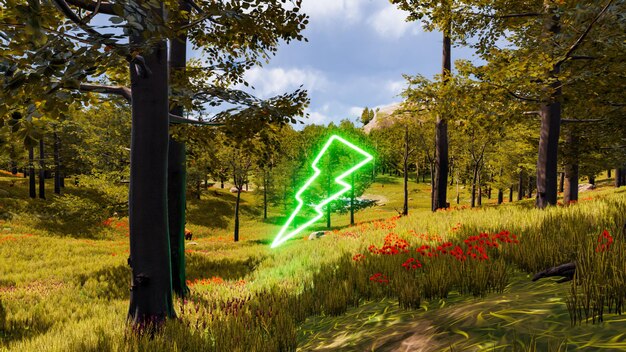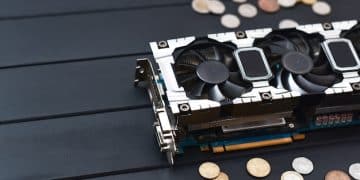PC Gaming’s Environmental Impact: Sustainable Practices for US Gamers

Exploring the significant environmental footprint of PC gaming, this article delves into key areas of impact, from hardware manufacturing to energy consumption, and provides actionable sustainable practices for US gamers to reduce their ecological impact effectively.
As the vibrant world of PC gaming continues to expand, its environmental footprint becomes an increasingly critical discussion. The Environmental Impact of PC Gaming: Sustainable Practices for US Gamers raises important questions about how our passion for high-performance hardware and immersive virtual worlds intersects with ecological responsibility. This article explores the various facets of this impact and offers practical, actionable strategies for gamers in the US to embrace a more sustainable future.
Understanding the Environmental Footprint of PC Gaming
The journey of a PC, from its inception to its eventual disposal, carries a substantial environmental burden. This section unravels the complex web of impacts, highlighting how each stage contributes to the overall ecological cost of our gaming habits.
Every component within a gaming PC—from the intricate circuits of a GPU to the plastic casing of a monitor—requires raw materials extracted from the earth. The mining of rare earth minerals like neodymium, coltan, and palladium, essential for modern electronics, often involves ecologically damaging practices, including habitat destruction, water contamination, and significant energy consumption. This initial phase sets the stage for the environmental challenges ahead.
Manufacturing and Supply Chain Emissions
The manufacturing process itself is incredibly energy-intensive. Fabricating silicon chips, assembling circuit boards, and constructing power supplies demand vast amounts of electricity, much of which is still generated from fossil fuels. Beyond the direct energy use, the global supply chain—transporting raw materials, components, and finished products across continents—adds substantially to carbon emissions through shipping and freight. These logistical complexities, while often out of the individual consumer’s direct control, form a critical part of the industry’s overall environmental impact.
- Resource Depletion: Reliance on finite mineral resources.
- Toxic Byproducts: Chemical waste from fabrication processes.
- Global Transport: Significant carbon footprint from shipping.
- Energy Usage: High electricity demand in factories worldwide.
Energy Consumption During Gameplay
Once a gaming PC is in use, its primary environmental impact shifts to energy consumption. High-end gaming rigs, designed for peak performance and visual fidelity, can draw hundreds of watts of power. While individual sessions might seem insignificant, collectively, millions of gamers across the US contribute to a considerable demand on the electrical grid. This demand, particularly if met by non-renewable energy sources, directly translates into greenhouse gas emissions. The continuous evolution of hardware, pushing the boundaries of graphical realism, often comes with an increased power requirement, posing a persistent challenge for energy efficiency.
Moreover, the energy equation extends beyond just the PC itself. Peripherals, monitors, and networking equipment all consume power, subtly adding to the overall draw. Even when idle, many devices engage in “phantom load,” drawing small amounts of power continually. Understanding this persistent energy demand is the first step toward mitigating its environmental consequences.
Optimizing Hardware for Reduced Impact
Choosing and managing your PC hardware wisely can significantly reduce your environmental footprint. This section delves into practical strategies for making eco-conscious decisions when building, upgrading, and maintaining your gaming rig.
When selecting new components, prioritize energy efficiency ratings. Graphics cards and power supplies often come with efficiency certifications (like 80 Plus for PSUs), indicating how much power is converted into usable energy verses wasted as heat. Higher efficiency means less power drawn from the wall for the same performance. Investing in components designed for lower power consumption, even at a slightly higher upfront cost, can lead to long-term environmental and financial savings.
Strategic Upgrades and Second-Hand Components
Instead of constantly buying brand-new systems, consider strategic upgrades. Often, replacing a single component, like a GPU or CPU, can extend the life of your existing PC for several years. This reduces demand for new manufacturing and minimizes electronic waste. Furthermore, the second-hand market for PC components is thriving. Purchasing used, but well-maintained, parts not only saves money but also gives components a second life, directly preventing them from ending up in landfills prematurely. Websites and forums dedicated to PC part resales are excellent resources for this eco-friendly approach.
- Component Lifespan: Extend life through targeted upgrades.
- Circular Economy: Support the reuse of hardware.
- Financial Savings: Often cheaper than buying new.
- Reduced Waste: Divert e-waste from landfills.
Proper Maintenance and Longevity
Regular maintenance is key to extending the lifespan of your PC and reducing the need for premature replacements. Simple practices like cleaning dust out of components, ensuring adequate cooling, and updating drivers can prevent overheating and component failure. A well-maintained system runs more efficiently and lasts longer, directly contributing to a smaller environmental impact. This proactive approach not only benefits the planet but also ensures your gaming experience remains optimal for years to come.
Understanding the common points of wear and tear, such as fan bearings or thermal paste, allows for timely interventions that prevent cascading failures. By treating your PC as an investment rather than a disposable item, you naturally align with more sustainable practices, reducing consumption and waste in the long run.

Energy-Efficient Gaming Habits
Beyond hardware choices, your daily gaming habits play a significant role in your PC’s energy consumption. Adopting more energy-efficient practices can collectively lead to substantial reductions in power usage across the gaming community.
One of the simplest yet most effective measures is utilizing your operating system’s power management features. Setting your PC to enter sleep mode after a period of inactivity, or configuring display settings to turn off after a few minutes, can prevent unnecessary power draw. Many modern operating systems offer “balanced” or “power saver” profiles that dynamically adjust performance to match demand, reducing energy use when full power isn’t required.
Optimizing Game Settings and Resolutions
While aspiring for the highest frame rates and graphical fidelity is common, consider if it’s always necessary. Lowering in-game resolution, adjusting anti-aliasing settings, or reducing shadow quality can significantly decrease the load on your GPU and CPU, thereby lowering power consumption, often with minimal discernible impact on the gaming experience. Experiment with settings to find the sweet spot between visual quality and energy efficiency that suits your preferences.
- FPS Caps: Limit frame rates to match monitor refresh rates, avoiding unnecessary GPU strain.
- Vertical Sync (V-Sync): Align game frame rate with monitor refresh rate, reducing GPU overwork.
- Texture Quality: Lowering texture resolution can ease memory and GPU demands.
- Lighting Effects: Complex lighting often requires high power; consider slight reductions.
Smart Shutdowns and Unplugging
When you’re finished gaming for the day, a full shutdown is more energy-efficient than leaving your PC in sleep mode, especially overnight. While sleep modes consume very little power, over extended periods, this “phantom load” accumulates. Disconnecting peripherals like external hard drives or charging cables when not in use also prevents unnecessary power draw. For true zero consumption, unplugging devices or using a power strip with an on/off switch can completely cut off power to your setup.
This attention to detail in shutting down and unplugging might seem minor for a single session, but aggregated over days, weeks, and months, it significantly reduces your household’s overall energy footprint, aligning your gaming passion with responsible energy stewardship.
The Role of Renewable Energy and Carbon Offsetting
Individual actions are powerful, but the larger energy landscape also matters. Understanding and embracing renewable energy options, as well as considering carbon offsetting, provides a broader perspective on sustainable gaming.
For US gamers, switching to a utility provider that sources electricity from renewable origins (like solar, wind, or hydro) is one of the most impactful steps. Many utility companies now offer “green energy” plans, allowing consumers to directly support clean energy generation. Even if your local grid still primarily uses fossil fuels, by opting for these plans, you create market demand for renewables, accelerating the transition to a greener energy infrastructure. Research your local utility’s options or explore third-party renewable energy providers in your state.
Carbon Offsetting Gaming Emissions
Carbon offsetting involves investing in projects that reduce greenhouse gas emissions elsewhere to compensate for your own emissions. While not a substitute for reduction, it can be a supplementary measure. Several organizations offer options to calculate your estimated PC gaming carbon footprint (based on average usage and energy consumption) and then purchase offsets through reforestation projects, renewable energy initiatives, or methane capture programs. This allows gamers to financially contribute to environmental restoration and clean energy development.
- Verified Projects: Opt for offsets from reputable, verified programs.
- Direct Impact: Support specific environmental benefit initiatives.
- Global Reach: Contribute to carbon reduction efforts worldwide.
- Awareness: Increases understanding of personal carbon footprint.
Advocating for Greener Tech and Policies
Beyond personal practices, gamers can advocate for industry-wide change. Support manufacturers who prioritize sustainable sourcing, produce energy-efficient components, and offer robust recycling programs. Engage with gaming communities to raise awareness about environmental issues. Furthermore, support policies that promote renewable energy infrastructure, incentivize eco-friendly manufacturing, and establish better e-waste recycling regulations. Collective action and advocacy can drive significant advancements in making the entire PC gaming ecosystem more sustainable.
Lobbying for “Right to Repair” legislation, for instance, empowers consumers to fix their devices rather than replace them, extending product lifespans and curbing e-waste. By using your voice as a consumer and citizen, you contribute to systemic shifts necessary for a truly sustainable future in technology and beyond.
E-Waste Management and Responsible Disposal
The lifecycle of a gaming PC inevitably ends, and how we manage its disposal is crucial for minimizing environmental harm. Electronic waste, or e-waste, contains hazardous materials that can leach into soil and water if not handled properly.
When your PC components reach their end of life, avoid simply throwing them in the regular trash. Many states and municipalities in the US have specific e-waste recycling programs. These programs ensure that valuable materials like gold, copper, and platinum can be recovered and reused, reducing the need for new mining. More importantly, hazardous substances such as lead, mercury, and cadmium are safely processed and prevented from contaminating the environment.
Certified Recycling Programs and Take-Back Schemes
Look for certified e-waste recyclers who adhere to strict environmental standards. Organizations like the Responsible Recycling (R2) certification or e-Stewards certification ensure that electronics are recycled responsibly, often domestically, without contributing to harmful practices like illegal global waste dumping. Many electronics manufacturers also offer take-back programs for their old products, often providing convenient drop-off locations or mail-in options. Research these options to ensure your old hardware is processed ethically.
- Local Facilities: Check municipal recycling websites for nearby e-waste drop-offs.
- Retailer Programs: Some electronics stores offer recycling services for old devices.
- Manufacturer Buy-Backs: Brands like Dell and HP have programs for returning old products.
- Community Events: Look for special e-waste collection drives in your area.
Donation and Repurposing Old Hardware
Before recycling, consider if your old components or entire system can still be useful. Functioning hardware can be donated to schools, charities, or organizations that refurbish computers for low-income families. This extends the lifespan of the electronics and provides access to technology for those who might not otherwise afford it. Even non-functional parts can sometimes be repurposed for art projects or as spare parts for repairs by technical hobbyists. Maximizing reuse is always preferable to recycling when possible.
For example, an older graphics card might no longer run the latest AAA titles, but it could be perfectly adequate for a budget gaming build, a home media server, or a computer for basic productivity tasks. Encouraging a culture of reuse helps to minimize resource consumption and waste across the board.
The Future of Sustainable Gaming Technology
The concept of “green gaming” is evolving rapidly, driven by technological advancements and increasing consumer awareness. Emerging trends in hardware design, energy solutions, and industry practices promise a more sustainable future for PC gaming.
Manufacturers are investing heavily in research and development to produce more energy-efficient components. This includes improvements in chip architecture that deliver higher performance per watt, more efficient power delivery systems, and innovative cooling solutions that reduce overall energy draw. The integration of artificial intelligence in power management within operating systems and hardware itself is also leading to more dynamic and precise energy optimization.
Modular Design and Biodegradable Materials
The push for modular PC designs is gaining traction, allowing for easier component replacement and upgrades. This extends product lifespans and reduces the need to discard an entire system due to a single failed part. Furthermore, there’s growing interest in utilizing more sustainable materials in manufacturing, including recycled plastics, bio-based polymers, and even biodegradable components for non-critical parts. While still in early stages, these material innovations could significantly reduce the environmental impact of hardware production and end-of-life disposal.
- Standardized Components: Easier interchangeability and repair.
- Recycled Content: Increased use of post-consumer plastics and metals.
- Bio-plastics: Exploring plant-based alternatives for casings and non-load-bearing parts.
- Design for Disassembly: Products designed to be easily taken apart for recycling.
Cloud Gaming and Its Environmental Implications
Cloud gaming services like GeForce Now and Xbox Cloud Gaming offer an interesting alternative. By streaming games from remote servers, users don’t need a powerful local PC, theoretically reducing individual hardware consumption. However, the energy consumption shifts to large data centers, which require immense amounts of electricity for processing and cooling. The environmental burden of cloud gaming depends heavily on the energy source powering these data centers and their overall efficiency. While it presents a potential solution for some, a comprehensive environmental analysis is still evolving.
For many, the shift to cloud gaming represents a trade-off: reduced e-waste at the consumer end, but increased energy demand at the server farm level. Optimizing data center efficiency and transitioning them to renewable energy sources will be paramount to realizing the environmental benefits of cloud gaming on a larger scale.
Building an Eco-Conscious Gaming Community
Individual efforts are amplified when shared and embraced by a wider community. Fostering an eco-conscious gaming community can drive significant collective change and promote sustainable practices.
Share your experiences and tips for sustainable gaming with friends, on forums, and through social media. Discussing topics like energy-efficient hardware, responsible disposal, and the benefits of second-hand components can inspire others to adopt similar practices. Many gaming communities are ripe for discussions about environmental responsibility, given the younger demographic’s general concern for climate issues.
Supporting Green Initiatives and Brands
Actively seek out and support gaming brands and companies that demonstrate a genuine commitment to sustainability. This includes manufacturers with transparent supply chains, those using recycled materials, or companies investing in renewable energy for their operations. Your purchasing decisions send a clear message to the industry, signaling that environmental responsibility is a factor in consumer choice. Supporting game developers who integrate environmentally positive themes or donate to green causes can also be a way to align your gaming with your values.
- Transparent Reporting: Look for sustainability reports from companies.
- Product Certifications: Support products with eco-labels.
- Company Values: Research brands’ environmental commitments.
- Ethical Sourcing: Prefer companies that prioritize fair labor and material sourcing.
Organizing and Participating in Green Gaming Events
Consider organizing or participating in local “green gaming” events. This could involve workshops on PC maintenance for longevity, collection drives for e-waste, or online campaigns to raise awareness about energy efficiency. Collaborating with local environmental groups or tech recycling centers can expand the reach and impact of such initiatives. These events not only educate but also build a sense of collective responsibility and action within the gaming community, transforming a solitary hobby into a force for positive environmental change.
By engaging directly and indirectly with peers, gamers can transcend individual efforts and create a powerful movement towards a more sustainable and environmentally friendly future for the entire industry. The collective impact far outweighs the sum of individual actions.
| Key Aspect | Brief Description |
|---|---|
| 🌍 Environmental Footprint | From raw material extraction to energy consumption and e-waste, gaming PCs have a significant ecological impact. |
| 💡 Energy Efficiency | Optimize hardware choices and adopt smart gaming habits to reduce power consumption. |
| ♻️ Responsible Disposal | Utilize certified e-waste recycling and consider donating/repurposing old components. |
| 🌱 Community & Future | Advocate for green tech, support eco-conscious brands, and foster sustainable gaming communities. |
Frequently Asked Questions
▼
The biggest environmental impact comes from energy consumption during operation and the manufacturing process. The production of complex components requires significant energy and rare earth minerals, while high-performance gaming rigs draw considerable power from the grid during use, contributing to greenhouse gas emissions.
▼
You can reduce energy consumption by optimizing in-game settings (e.g., lowering resolution or capping FPS), using your operating system’s power management features, ensuring proper cooling, and fully shutting down your PC when not in use instead of just putting it to sleep.
▼
Yes, buying second-hand PC parts is environmentally friendly. It extends the lifespan of components, reduces the demand for new manufacturing, and lessens the amount of electronic waste headed for landfills. This contributes to a circular economy, minimizing resource depletion and pollution.
▼
E-waste refers to discarded electronic devices containing hazardous materials. To dispose of old PC components responsibly, utilize certified e-waste recycling programs, look for manufacturer take-back schemes, or explore local community recycling events. Avoid throwing them in regular trash to prevent environmental contamination.
▼
Absolutely. If your electricity comes from renewable sources like solar or wind, the energy consumed by your PC gaming setup no longer contributes to carbon emissions from fossil fuels. Switching to a green energy plan or supporting renewable energy initiatives can significantly diminish your gaming’s carbon footprint.
Conclusion
The intersection of PC gaming and environmental sustainability is a multifaceted challenge, yet one filled with opportunities for positive change. From the careful selection of energy-efficient hardware and the adoption of mindful gaming habits to advocating for broader industry shifts and responsible e-waste management, every gamer in the US holds a piece of the solution. By embracing these sustainable practices, you not only contribute to a healthier planet but also set a precedent for a more conscious and responsible gaming community. The future of gaming can indeed be both high-performance and environmentally sound, but it requires continuous commitment and collective effort.





